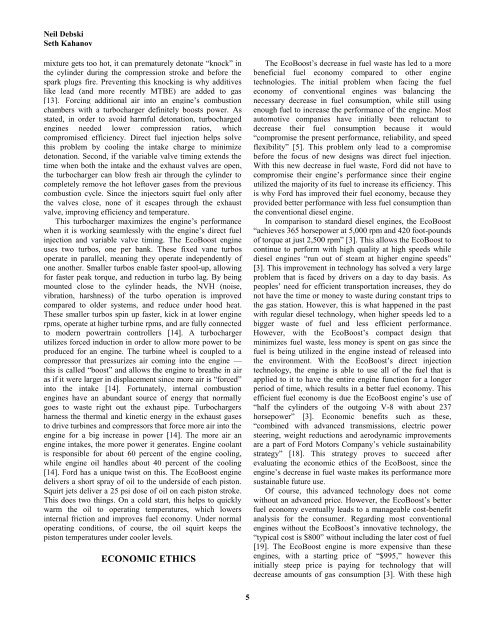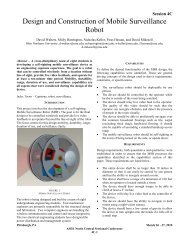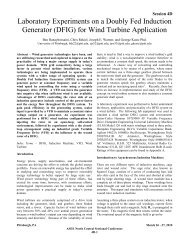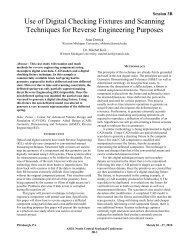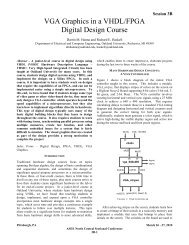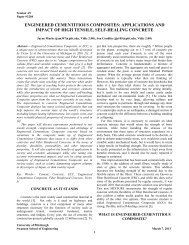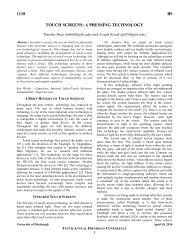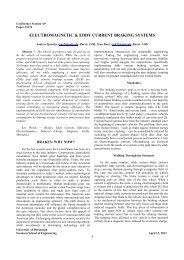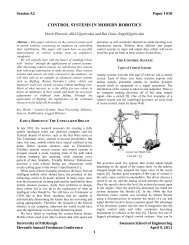THE ECOBOOST ENGINE: COMBINING VARIABLE VALVE TIMING ...
THE ECOBOOST ENGINE: COMBINING VARIABLE VALVE TIMING ...
THE ECOBOOST ENGINE: COMBINING VARIABLE VALVE TIMING ...
You also want an ePaper? Increase the reach of your titles
YUMPU automatically turns print PDFs into web optimized ePapers that Google loves.
Neil Debski<br />
Seth Kahanov<br />
mixture gets too hot, it can prematurely detonate “knock” in<br />
the cylinder during the compression stroke and before the<br />
spark plugs fire. Preventing this knocking is why additives<br />
like lead (and more recently MTBE) are added to gas<br />
[13]. Forcing additional air into an engine’s combustion<br />
chambers with a turbocharger definitely boosts power. As<br />
stated, in order to avoid harmful detonation, turbocharged<br />
engines needed lower compression ratios, which<br />
compromised efficiency. Direct fuel injection helps solve<br />
this problem by cooling the intake charge to minimize<br />
detonation. Second, if the variable valve timing extends the<br />
time when both the intake and the exhaust valves are open,<br />
the turbocharger can blow fresh air through the cylinder to<br />
completely remove the hot leftover gases from the previous<br />
combustion cycle. Since the injectors squirt fuel only after<br />
the valves close, none of it escapes through the exhaust<br />
valve, improving efficiency and temperature.<br />
This turbocharger maximizes the engine’s performance<br />
when it is working seamlessly with the engine’s direct fuel<br />
injection and variable valve timing. The EcoBoost engine<br />
uses two turbos, one per bank. These fixed vane turbos<br />
operate in parallel, meaning they operate independently of<br />
one another. Smaller turbos enable faster spool-up, allowing<br />
for faster peak torque, and reduction in turbo lag. By being<br />
mounted close to the cylinder heads, the NVH (noise,<br />
vibration, harshness) of the turbo operation is improved<br />
compared to older systems, and reduce under hood heat.<br />
These smaller turbos spin up faster, kick in at lower engine<br />
rpms, operate at higher turbine rpms, and are fully connected<br />
to modern powertrain controllers [14]. A turbocharger<br />
utilizes forced induction in order to allow more power to be<br />
produced for an engine. The turbine wheel is coupled to a<br />
compressor that pressurizes air coming into the engine —<br />
this is called “boost” and allows the engine to breathe in air<br />
as if it were larger in displacement since more air is “forced”<br />
into the intake [14]. Fortunately, internal combustion<br />
engines have an abundant source of energy that normally<br />
goes to waste right out the exhaust pipe. Turbochargers<br />
harness the thermal and kinetic energy in the exhaust gases<br />
to drive turbines and compressors that force more air into the<br />
engine for a big increase in power [14]. The more air an<br />
engine intakes, the more power it generates. Engine coolant<br />
is responsible for about 60 percent of the engine cooling,<br />
while engine oil handles about 40 percent of the cooling<br />
[14]. Ford has a unique twist on this. The EcoBoost engine<br />
delivers a short spray of oil to the underside of each piston.<br />
Squirt jets deliver a 25 psi dose of oil on each piston stroke.<br />
This does two things. On a cold start, this helps to quickly<br />
warm the oil to operating temperatures, which lowers<br />
internal friction and improves fuel economy. Under normal<br />
operating conditions, of course, the oil squirt keeps the<br />
piston temperatures under cooler levels.<br />
ECONOMIC ETHICS<br />
The EcoBoost’s decrease in fuel waste has led to a more<br />
beneficial fuel economy compared to other engine<br />
technologies. The initial problem when facing the fuel<br />
economy of conventional engines was balancing the<br />
necessary decrease in fuel consumption, while still using<br />
enough fuel to increase the performance of the engine. Most<br />
automotive companies have initially been reluctant to<br />
decrease their fuel consumption because it would<br />
“compromise the present performance, reliability, and speed<br />
flexibility” [5]. This problem only lead to a compromise<br />
before the focus of new designs was direct fuel injection.<br />
With this new decrease in fuel waste, Ford did not have to<br />
compromise their engine’s performance since their engine<br />
utilized the majority of its fuel to increase its efficiency. This<br />
is why Ford has improved their fuel economy, because they<br />
provided better performance with less fuel consumption than<br />
the conventional diesel engine.<br />
In comparison to standard diesel engines, the EcoBoost<br />
“achieves 365 horsepower at 5,000 rpm and 420 foot-pounds<br />
of torque at just 2,500 rpm” [3]. This allows the EcoBoost to<br />
continue to perform with high quality at high speeds while<br />
diesel engines “run out of steam at higher engine speeds”<br />
[3]. This improvement in technology has solved a very large<br />
problem that is faced by drivers on a day to day basis. As<br />
peoples’ need for efficient transportation increases, they do<br />
not have the time or money to waste during constant trips to<br />
the gas station. However, this is what happened in the past<br />
with regular diesel technology, when higher speeds led to a<br />
bigger waste of fuel and less efficient performance.<br />
However, with the EcoBoost’s compact design that<br />
minimizes fuel waste, less money is spent on gas since the<br />
fuel is being utilized in the engine instead of released into<br />
the environment. With the EcoBoost’s direct injection<br />
technology, the engine is able to use all of the fuel that is<br />
applied to it to have the entire engine function for a longer<br />
period of time, which results in a better fuel economy. This<br />
efficient fuel economy is due the EcoBoost engine’s use of<br />
“half the cylinders of the outgoing V-8 with about 237<br />
horsepower” [3]. Economic benefits such as these,<br />
“combined with advanced transmissions, electric power<br />
steering, weight reductions and aerodynamic improvements<br />
are a part of Ford Motors Company’s vehicle sustainability<br />
strategy” [18]. This strategy proves to succeed after<br />
evaluating the economic ethics of the EcoBoost, since the<br />
engine’s decrease in fuel waste makes its performance more<br />
sustainable future use.<br />
Of course, this advanced technology does not come<br />
without an advanced price. However, the EcoBoost’s better<br />
fuel economy eventually leads to a manageable cost-benefit<br />
analysis for the consumer. Regarding most conventional<br />
engines without the EcoBoost’s innovative technology, the<br />
“typical cost is $800” without including the later cost of fuel<br />
[19]. The EcoBoost engine is more expensive than these<br />
engines, with a starting price of “$995,” however this<br />
initially steep price is paying for technology that will<br />
decrease amounts of gas consumption [3]. With these high<br />
5


